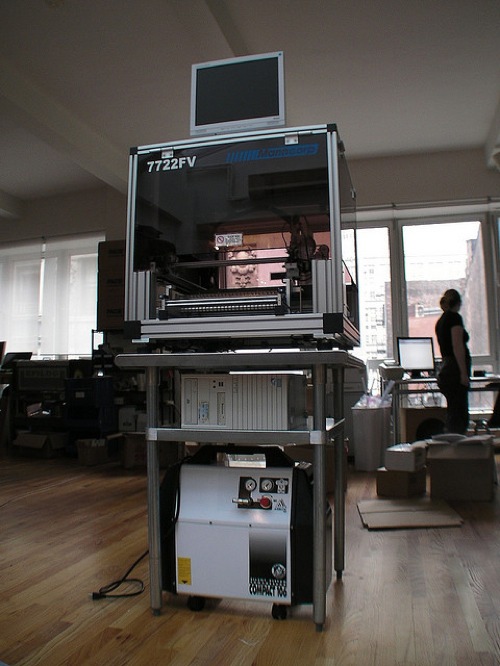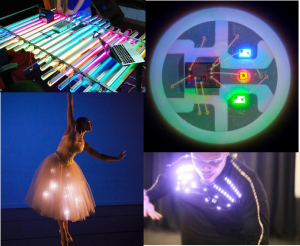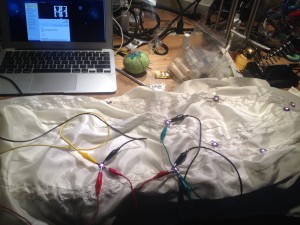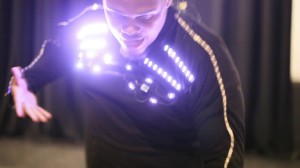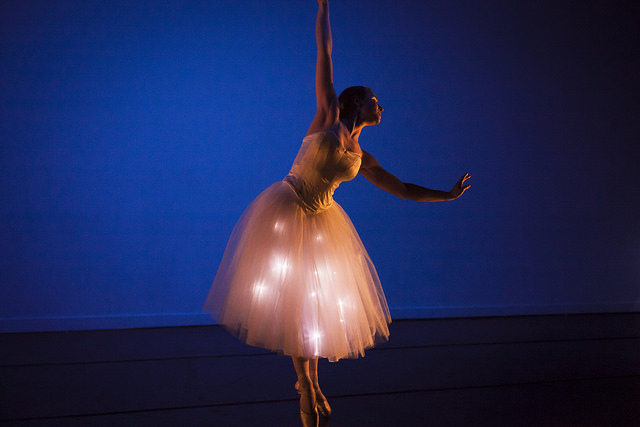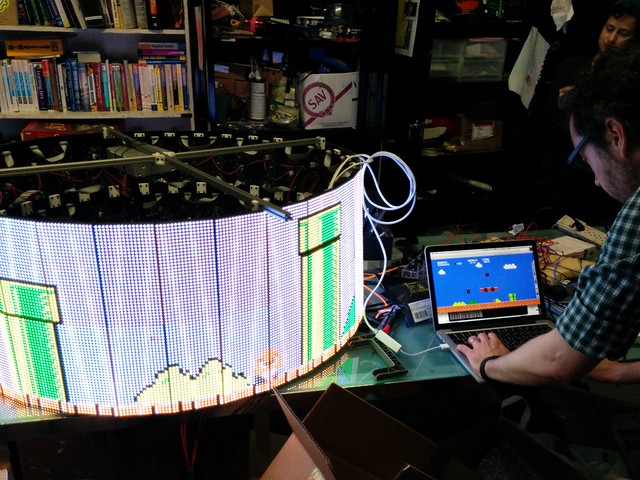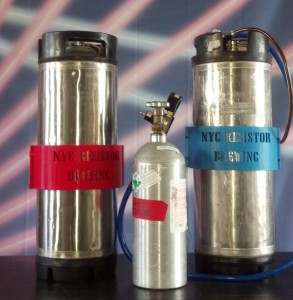Ronald Huveneers decided that reverse engineering an NES was too easy, so he started reverse engineering our Pick and Place machine.
Solder paste

If you find yourself soldering tiny SMD packages, like these dual MOSFETs, you might pull out the microscope and get to see the solder paste for what it really is:
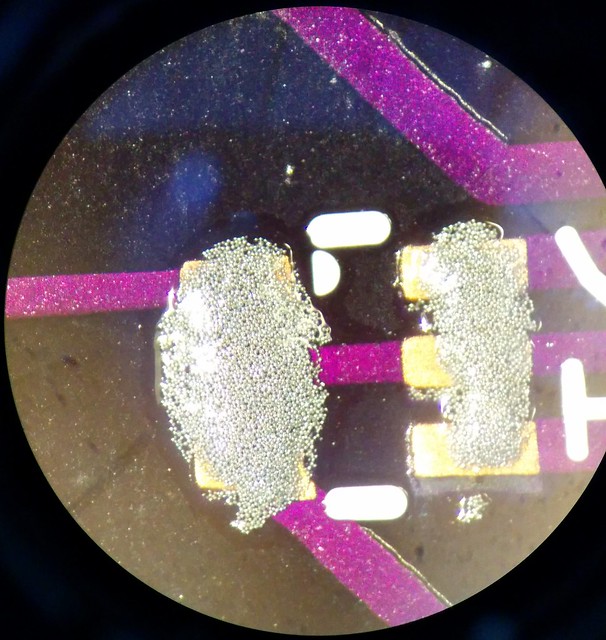
So many tiny balls of solder! And as all of the microscopic spheres melt, surface tension pulls the blob onto the pads in the most amazing way.
Learning Programming with NeoPixels
Have you been wanting to dip your toe into the world of programming but you’re not sure where to start? Need a gentle introduction that assumes no prior knowledge? I have a class for you.
This Saturday we’ll be teaching a class on programming NeoPixels with the Adafruit Flora microcontroller. I love programming things that blink because not only are you controlling something in the real world, but you can also instantly “see” what your code is doing. And NeoPixels are nice because there is no breadboarding. You just tie two components together with 3 wires, and off you go. You don’t even have to solder.
In the class on Saturday we will be teaching the basics of programming (what is a data type? how do loops work?, etc.) using several sample programs that you will learn to edit to change patterns. It’s a great way to get acquainted with what programming is like, and to learn some fundamentals. You can get tickets here.
And don’t worry, class will end before the World Cup begins, and you’re welcome to stay and watch the game on our big screen.
And if you do have experience programming, and would like to branch out into Arduino-based blinky things, we have a NeoPixel programming class for experienced coders on Sunday. Tickets are here.
Want to add blink to your wardrobe? Want to light up the night at Burning Man or the next NYC dance party? This intro class covers materials for illuminating your outfits. With a mixture of hands-on tutorials and demos we’ll teach you how to incorporate LEDs, NeoPixels, EL Wire, and fiber optic filament into your outfits.
This is an assembly-only class, no programming, but we will be providing some basic code to get you up and running. You are welcome to bring an outfit to add NeoPixels to, or we will provide a fabric swatch to practice on. Don’t forget your laptop! Get your tickets here.
Instructors for this class include team members responsible for our recent and on-going collaboration with the Brooklyn Ballet, adding blinky technology to the dancers’ costumes.
laser is back up!

Our laser is back in action!
Is something metal burning?
On Friday night I experienced what is probably my most spectacular hardware failure yet. I was working on a project for our upcoming Interactive Show, a chandelier with 150 or so individually controllable 5 watt incandescent bulbs:
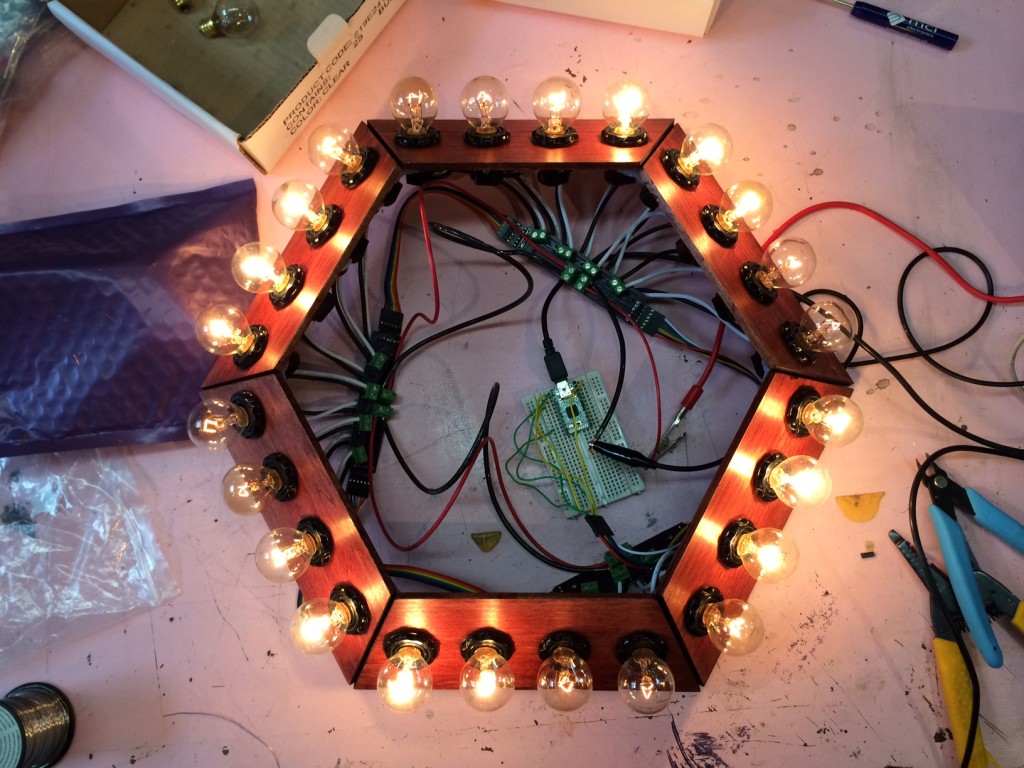
A small piece of the chandelier during testing.
Anyway, it was way too late and I was rushing to get the last controller board finished on the outer ring of the chandelier, which has 7 controllers and 52 lightbulbs. I plugged the very last controller in backwards and flipped the switch…
Continue reading »
On ~*June 28th*~ we’ll be hosting a new class on hacking NES cartridges for art and various related shenanigans. Cory Arcangel’s Super Mario Clouds is a well known work of digital art where a Nintendo game cartridge was modified to just show the clouds in the game. He also happened to release some instructions on how to reproduce his leet hax! In this workshop, we’ll be creating Super Mario Clouds from old NES cartridges, bringing modern art to your living room without having to splurge at Art Basel. Some basic soldering, desoldering, and programming will also be covered as a bonus since that’s how old NES cartridges are hacked.
Limited to 12 spots and includes your very own old Super Mario cartridge.
This class will be taught by NYC Resistor member David Huerta and Jon Dahan, who crafted this workshop after his experience re-creating it at the Metropolitan Art Museum’s Media Lab. Sign up on Eventbrite.
Megascroller Mario at the Interactive Show
Megascroller is the 512×64, 32-sided upgrade to Octoscroller, which was the eight sided RGB update to the venerable six-sided red LED Hexascroller. Megascroller is featured as one of the art pieces at the upcoming Interactive Show — on the giant cylinder you can play different video games in the round. Unlike normal side-scrollers, you have to move sideways to keep up with the onscreen characters. Here’s a video as we play-test Mario (source code) and discuss some tweaks to the game to enhance the fun (there is some interaction with the camera shutter that makes artifacts in the movie).
Buy your tickets now! and come see Megascroller plus lots of other fun interactive art at the 2014 Interactive Show. The doors open this Saturday at 8pm! The show is over and was great fun! Here’s a video of Mario being played in the round sometime late last night:
GET LAMP
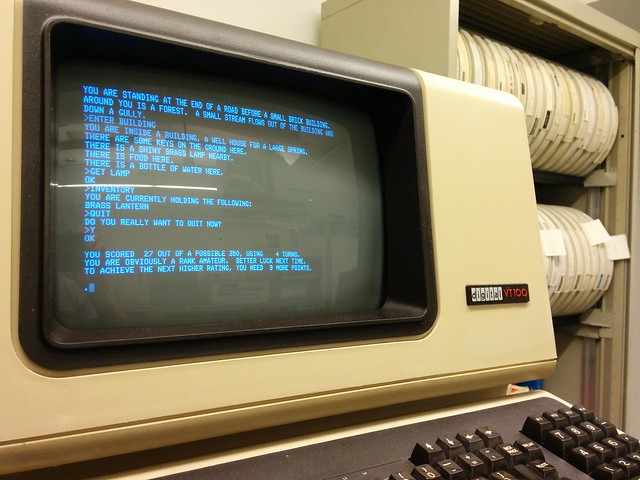
Two weeks ago we salvaged two PDP-11/34 minicomputers, VT1xx terminals and assorted parts. Since then we’ve spent some quality time in the 1970s, cleaning Unibus contacts, reseating cards and replacing bad capacitors in the VT100 analog boards. Both of the CPUs start up fine and we’ve been able to read data from all of the RK05 and RL01 drive units. Still haven’t touched the tape drives, so no digitized monkey brains yet. Instead, here is a video of running Colossal Cave Adventure compiled from the original FORTRAN IV sources under RT-11v4 on our PDP-11/34:
Brewing Status: Interactive Party
Interactive Party – Homebrew Bar
So with the interactive party around the corner, Travis Collins and I ( Matt Joyce ) have been working on the final touches for 3 homebrew beers that have been brewed at NYC Resistor. I figured that I would take a moment to introduce you to each of them.
NYC Resistor is on the site of a former brewery that operated from 1850-1907, finishing it’s days as the Federal Brewing Co. They used to brew German style bock beer to beer purity standards. Things in the US have changed considerably since the hay day of Brooklyn’s brewing industry. Among those changes is our complete departure not only from German style beers but from beer purity laws as well. Much of what we drink in the US, isn’t even allowed to be called Beer in some parts of Europe. We don’t care. We left Europe and told those stick in the muds to shove off for a reason. We love freedom, and exploration, and really wild new things.
So, for this party, I put together at least one new wild beer for your consumption, revulsion, or love.
